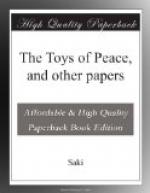Mrs. Hatch-Mallard renewed the lease in due course, but Ada Bleek has never renewed her friendship.
THE MAPPINED LIFE
“These Mappin Terraces at the Zoological Gardens are a great improvement on the old style of wild-beast cage,” said Mrs. James Gurtleberry, putting down an illustrated paper; “they give one the illusion of seeing the animals in their natural surroundings. I wonder how much of the illusion is passed on to the animals?”
“That would depend on the animal,” said her niece; “a jungle-fowl, for instance, would no doubt think its lawful jungle surroundings were faithfully reproduced if you gave it a sufficiency of wives, a goodly variety of seed food and ants’ eggs, a commodious bank of loose earth to dust itself in, a convenient roosting tree, and a rival or two to make matters interesting. Of course there ought to be jungle-cats and birds of prey and other agencies of sudden death to add to the illusion of liberty, but the bird’s own imagination is capable of inventing those—look how a domestic fowl will squawk an alarm note if a rook or wood pigeon passes over its run when it has chickens.”
“You think, then, they really do have a sort of illusion, if you give them space enough—”
“In a few cases only. Nothing will make me believe that an acre or so of concrete enclosure will make up to a wolf or a tiger-cat for the range of night prowling that would belong to it in a wild state. Think of the dictionary of sound and scent and recollection that unfolds before a real wild beat as it comes out from its lair every evening, with the knowledge that in a few minutes it will be hieing along to some distant hunting ground where all the joy and fury of the chase awaits it; think of the crowded sensations of the brain when every rustle, every cry, every bent twig, and every whiff across the nostrils means something, something to do with life and death and dinner. Imagine the satisfaction of stealing down to your own particular drinking spot, choosing your own particular tree to scrape your claws on, finding your own particular bed of dried grass to roll on. Then, in the place of all that, put a concrete promenade, which will be of exactly the same dimensions whether you race or crawl across it, coated with stale, unvarying scents and surrounded with cries and noises that have ceased to have the least meaning or interest. As a substitute for a narrow cage the new enclosures are excellent, but I should think they are a poor imitation of a life of liberty.”
“It’s rather depressing to think that,” said Mrs. Gurtleberry; “they look so spacious and so natural, but I suppose a good deal of what seems natural to us would be meaningless to a wild animal.”
“That is where our superior powers of self-deception come in,” said the niece; “we are able to live our unreal, stupid little lives on our particular Mappin terrace, and persuade ourselves that we really are untrammelled men and women leading a reasonable existence in a reasonable sphere.”




